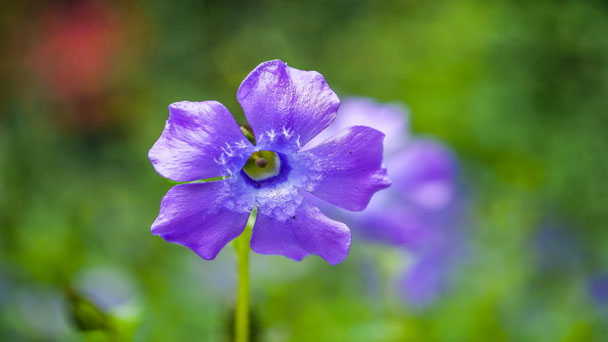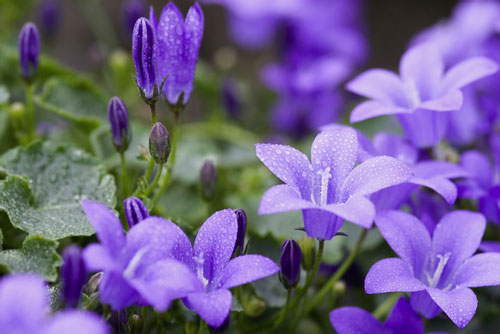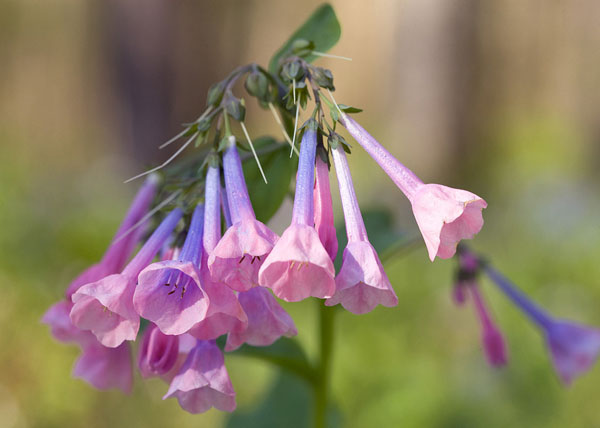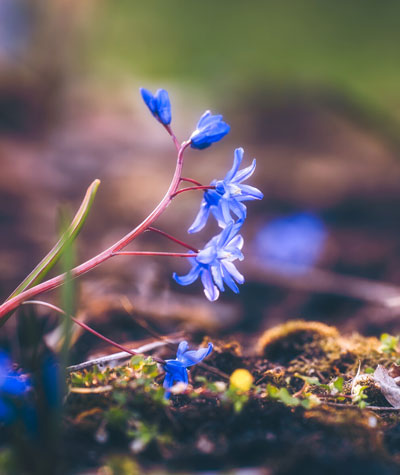Siberian Squill (Scilla Siberica) Grow & Care Guide
Written by Iris
Oct 13 2021

Siberian Squill (Siberian Squill Siberica) is a kind of flowering plant propagated by bulbs. The plant is very small and suitable for planting. It can be grown in a large area in the yard or can be grown in a small flower pot to become a very charming small potted plant. Siberian Squill can bloom charming blue flowers. Siberian Squill like a warm, humid and semi-shady environment all year round. Places that do not require much light must be ventilated and light to avoid overheating. The most amazing thing is that Siberian Squill has cold tolerance. The lowest temperature in winter can survive at minus 20 degrees. Of course, if you want it to grow well, you must maintain a cool environment all year round, with a temperature of 15 to 16 degrees. It grows most vigorously in the middle, and you can choose to cultivate after it gets cooler in autumn.
Plant the bulbs about 3 to 5 inches deep—you can space them close together, planting about 15 bulbs per square foot or one bulb every 3 inches. siberian squill bulbs are often sold in bulk packages of 100 or more, and it's generally easier to dig a wide hole and plant several bulbs at the same time rather than poking many individual holes.
Siberian squill plants won't be around past the cool, early months of spring, so little maintenance is required. Don't mow the foliage down until about six weeks after the flowers bloom, as the plants need time to create and store energy, before going dormant.
If you would like to transplant your squill, you can either move a clump of bulbs or save the seed. Fall is ideal for transplanting bulbs, but it's easier to find them while they are still in bloom. If you move them then, be sure to keep them well watered until they get established. You can also transplant any bulbs you forced in containers. After they have completed blooming, plant the bulbs in the garden 3 to 5 inches deep and keep them watered until the foliage disappears.
To save seeds, allow the pods to dry on the plants and then collect them and scatter them where you want—they will grow themselves.
Siberian Squill work well for naturalizing a large area. To attain this look, simply map out an area you would like to naturalize and dig the entire area about 2-3" deep. Scatter the bulbs throughout the area for a natural look.
If not naturalizing, plant the bulbs approximately 2-3" below the soil's surface. Dig holes for each bulb individually or dig a hole slightly larger and evenly space an odd number of bulbs in the bottom for more of a "bouquet" look.
The bulbs of Siberian Squill are slightly rounded with points on the tops; plant the bulbs so that these points are facing up to the surface of the soil.
Thoroughly soak the area with water once all the bulbs have been planted. Roots will form in fall and then the bulb will sprout and bloom in spring. Water as needed while the plant is growing and blooming.
After the flowers have died, allow the foliage to yellow and die back. The leaves will continue to gather sunlight and make food for next year's blooms.
Once the foliage has yellowed and dried, the foliage may be removed by gently pulling it out of the soil. If the leaves do not easily pull away from the bulb, they are not ready to be removed. After the foliage has been removed, your Siberian Squill bulbs will be dormant and ready to "rest" until next year.
Temperature and Humidity
As their name and native area suggest, Siberian squill flowers are incredibly cold hardy, and have been known to grow as far north as the Arctic circle. Because of this, the plant has no special temperature or humidity needs, beyond that of a cold environment to initially grow and take root.
For severe mold growth, the bulbs need tossing. For minor mold growth, treat with fungicide.
TIP: Use a fungicide powder to dust the bulbs before planting lightly.
Soaking the bulbs in a mixture of warm water and liquid fungicide for a half hour is also helpful.
Siberian Squill sibirica taurica – has bright blue flowers, and is the most popular variety of siberian squill in gardens today.
Spring Beauty – this variety also has bright blue flowers, but the flowerheads are bigger than the Siberian Squill sibirica taurica, they bloom for a longer period, and the stems are sturdier, so as to better support the larger flowers that the Beauty produces. They are also very popular, especially in the UK.
There is some misinformation about Siberian squill, “Spring Beauty,” petals being considered edible. While there may be some truth to it, I could find no website or source that would back up the claim, other than one site, that didn't seem to have a correct picture of spring beauty variety, as it was shown in pink, not bright blue, so we cannot recommend using the spring beauty petals
Alba – The alba variety is very similar to the Siberian Squill sibirica taurica, except that the flowerheads are pure white in color.
Most varieties produce strap-shaped leaves and a raceme which holds either drooping, bell-shaped blossoms or a globe or cone composed of star-shaped flowers. The most common color of Siberian Squill flowers is deep blue. Other varieties produce white, pink, and lavender.
How to Grow Siberian SquillSiberian Squill Propagation with SeedsSiberian Squill Propagation with BulbsHow to Care for Siberian SquillSiberian Squill Lighting RequirmentsSiberian Squill Soil CareSiberian Squill WateringSiberian Squill FertilizerSiberian Squill PruningSiberian Squill Pests & Diseases CareVarieties of Siberian Squill Siberian Squill FAQIs Siberian Squill poisonous?What does Siberian Squill look like?
How to Grow Siberian Squill
Siberian Squill Propagation with Seeds
Siberian Squill bulbs aren't large, so you'll want to plant quite a few to have any impact. The bulbs have a rounded bottom and the top comes to a point, which should be planted facing up. Even if planted improperly, the bulbs will quickly right themselves.Plant the bulbs about 3 to 5 inches deep—you can space them close together, planting about 15 bulbs per square foot or one bulb every 3 inches. siberian squill bulbs are often sold in bulk packages of 100 or more, and it's generally easier to dig a wide hole and plant several bulbs at the same time rather than poking many individual holes.
Siberian squill plants won't be around past the cool, early months of spring, so little maintenance is required. Don't mow the foliage down until about six weeks after the flowers bloom, as the plants need time to create and store energy, before going dormant.
If you would like to transplant your squill, you can either move a clump of bulbs or save the seed. Fall is ideal for transplanting bulbs, but it's easier to find them while they are still in bloom. If you move them then, be sure to keep them well watered until they get established. You can also transplant any bulbs you forced in containers. After they have completed blooming, plant the bulbs in the garden 3 to 5 inches deep and keep them watered until the foliage disappears.
To save seeds, allow the pods to dry on the plants and then collect them and scatter them where you want—they will grow themselves.
Siberian Squill Propagation with Bulbs
Siberian Squill are typically planted in fall. Their roots will form in fall and they will bloom in early spring. Like most bulbs, siberian squill do not enjoy sitting wet in the soil. Therefore, choose a location with well-drained soil that receives partial to full sun.Siberian Squill work well for naturalizing a large area. To attain this look, simply map out an area you would like to naturalize and dig the entire area about 2-3" deep. Scatter the bulbs throughout the area for a natural look.
If not naturalizing, plant the bulbs approximately 2-3" below the soil's surface. Dig holes for each bulb individually or dig a hole slightly larger and evenly space an odd number of bulbs in the bottom for more of a "bouquet" look.
The bulbs of Siberian Squill are slightly rounded with points on the tops; plant the bulbs so that these points are facing up to the surface of the soil.
Thoroughly soak the area with water once all the bulbs have been planted. Roots will form in fall and then the bulb will sprout and bloom in spring. Water as needed while the plant is growing and blooming.
After the flowers have died, allow the foliage to yellow and die back. The leaves will continue to gather sunlight and make food for next year's blooms.
Once the foliage has yellowed and dried, the foliage may be removed by gently pulling it out of the soil. If the leaves do not easily pull away from the bulb, they are not ready to be removed. After the foliage has been removed, your Siberian Squill bulbs will be dormant and ready to "rest" until next year.

How to Care for Siberian Squill
Siberian Squill Lighting Requirments
Majority of Siberian Squill varieties thrive in full sun to partial shade to dappled shade. It is good for your Siberian Squill to get full sun in winter while partial shade during summer. Outdoors, you can plant them anywhere, even under the tree shade where they can still get an adequate amount of sunlight. If placed in deep shade, your Siberian Squill may not blossom. However, Siberian Squill variety like the Spanish Bluebell dislikes full sun. It thrives best in partial or full shade. Generally, siberian squills are not particular about the light conditions as long as they get good light.Siberian Squill Soil Care
Siberian Squills are a pleasing addition to our dull garden beds. Plus, it is one of the earliest flowers that welcome the arrival of spring. This plant is not really picky about its soil, but Siberian Squills love average to medium soil that drains well. You can use peat moss, ground bark, compost, or decomposed manure to improve the draining ability of your soil. Waterlogged soils may damage your Siberian Squill bulbs and impair their growth and flowering. If grown indoors, better to plant it in a mixture of coarse sand and ordinary potting soil.Siberian Squill Watering
They do need regular water when first planted in mid-to-late fall, about a month before the first expected frost. Beyond that though, they don't need any watering and are drought-tolerant once their bulbs are established.Temperature and Humidity
As their name and native area suggest, Siberian squill flowers are incredibly cold hardy, and have been known to grow as far north as the Arctic circle. Because of this, the plant has no special temperature or humidity needs, beyond that of a cold environment to initially grow and take root.
Siberian Squill Fertilizer
Though Siberian squill does well on its own and will easily naturalize in your landscape, you can help guarantee healthy blooms by fertilizing the plants in late winter or early spring using fertilizer specially formulated for bulbs.Siberian Squill Pruning
Fortunately, Siberian Squills are low maintaining plants. They don't need any special pruning or grooming, especially if you prefer them to naturalize your lawn. Siberian Squills like to roam around so if you are maintaining a specific look of your garden, you can remove its offsets. After the blossoming season, Siberian Squill flowers will die, and the leaves may turn yellow. During this period, allow the leaves to wilt on their own rather than removing them. The yellowing foliage is still gathering sunlight and make food for the next flowering season. Once the leaves dry out, you can remove them by pulling them gently out of the soil.Siberian Squill Pests & Diseases Care
These plants rarely experience disease or pest problems except for gray mold.For severe mold growth, the bulbs need tossing. For minor mold growth, treat with fungicide.
TIP: Use a fungicide powder to dust the bulbs before planting lightly.
Soaking the bulbs in a mixture of warm water and liquid fungicide for a half hour is also helpful.

Varieties of Siberian Squill
There are only a handful of varieties of siberian squill that have been named by horticulturists.Siberian Squill sibirica taurica – has bright blue flowers, and is the most popular variety of siberian squill in gardens today.
Spring Beauty – this variety also has bright blue flowers, but the flowerheads are bigger than the Siberian Squill sibirica taurica, they bloom for a longer period, and the stems are sturdier, so as to better support the larger flowers that the Beauty produces. They are also very popular, especially in the UK.
There is some misinformation about Siberian squill, “Spring Beauty,” petals being considered edible. While there may be some truth to it, I could find no website or source that would back up the claim, other than one site, that didn't seem to have a correct picture of spring beauty variety, as it was shown in pink, not bright blue, so we cannot recommend using the spring beauty petals
Alba – The alba variety is very similar to the Siberian Squill sibirica taurica, except that the flowerheads are pure white in color.

Siberian Squill FAQ
Is Siberian Squill poisonous?
Most Siberian Squills contain chemicals and toxins that can cause discomfort, even vomiting when consumed by humans and animals. These chemicals are often used for rodenticides.What does Siberian Squill look like?
Siberian Squill is a spring-blooming bulb. Its height does not exceed three feet.Most varieties produce strap-shaped leaves and a raceme which holds either drooping, bell-shaped blossoms or a globe or cone composed of star-shaped flowers. The most common color of Siberian Squill flowers is deep blue. Other varieties produce white, pink, and lavender.

Latest Updated
- Benefits of Bugleweed - 7 Science-backed Health Benefits
- Bugleweed Dangers & Side Effects - Is It Poisonous?
- How to Plant Evergreen Trees - What You Should Know
- When to Plant Evergreens - Grow Guide for Evergreen Trees
- 12 Wonderful Evergreen Shrubs for Your Garden
- 12 Popular Evergreen Plants with Pictures for Beginners
- When And How To Prune A Lilac Bush Like a Pro
- How to Grow & Care for Lilac Vine (Hardenbergia Violacea)
- Japanese Lilac Tree (Syringa Reticulata) Care & Propagation Guide
- Shumard Oak Pros and Cons - What to Know
Popular Articles
- Winter maintenance of Antirrhinum Majus
- How to Grow Terminalia Mantaly Tree
- How to Grow and Care for Crossostephium Chinense
- How to grow Antirrhinum Majus in spring
- Peristeria Elata (Dove Orchid) Profile: Info & Care Guide
- Underwatered Snake Plant (Sansevieria Trifasciata) - Signs And How To Fix
- How to Care for Brazilian Jasmine Plant (Mandevilla Sanderi)
- How to Grow & Care for Graptopetalum Purple Delight in Summer
- Rosa Chinensis (China Rose): Plant Growing & Care Tips
- How to Care for Baby Sun Rose (Aptenia Cordifolia)